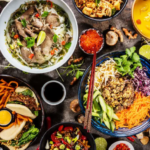
Nusantara Culinary: An Exploration of Indonesia’s Culinary Diversity
- 0
Indonesia’s rich culinary landscape, known as “Nusantara cuisine,” offers a tapestry of flavors and dishes that reflect the nation’s diverse cultures, ethnic groups, and geography. This vast archipelago, with over 17,000 islands, brings forth a variety of ingredients and cooking techniques that make Indonesian cuisine uniquely vibrant and flavorful. This article explores the traditional dishes, regional variations, and the cultural significance of Nusantara cuisine, providing a deep dive into one of Southeast Asia’s most flavorful culinary treasures.
Diversity in Ingredients and Flavors
Nusantara cuisine is characterized by its wide array of ingredients and bold flavors, ranging from spicy and sweet to savory and sour. Key ingredients include rice, a staple in all forms of Indonesian meals; spices such as turmeric, galangal, and lemongrass; and a variety of chili peppers that add heat to many dishes. Coconut milk is often used to soften the intense flavors and add a creamy texture, while fermented condiments like shrimp paste (terasi) and soy sauce (kecap) enhance the umami profile of the dishes.
Iconic Dishes of Nusantara Cuisine
Several dishes stand out as iconic representations of Nusantara cuisine. Nasi Goreng, Indonesia’s take on fried rice, is known worldwide and varies from region to region, often seasoned with kecap manis (sweet soy sauce) and mixed with seafood, chicken, or vegetables. Satay, skewered and grilled meats served with spicy peanut sauce, reflects the influence of street food culture across Indonesia. Another notable dish is Rendang, a slow-cooked curry typically made with beef, simmered in coconut milk and a complex mix of spices, originating from the Minangkabau ethnic group in West Sumatra.
Regional Variations and Specialties
Each region in Indonesia offers its own unique take on Nusantara cuisine, shaped by local ingredients and historical influences. In the fiery kitchens of Padang, bold spices dominate the dishes, while the food of Central Java is noted for its sweetness. Bali, with its Hindu traditions, offers a variety of pork dishes, such as Babi Guling (suckling pig), which are less common in the predominantly Muslim areas of Indonesia. The eastern islands like Maluku and Papua, with their abundant access to tropical fruits and seafood, bring forth dishes that emphasize fresh and tangy flavors.
Cultural Significance and Festive Foods
Food plays a central role in Indonesian culture, serving not only as sustenance but also as a means of social connection and ceremonial practice. Many dishes are closely tied to religious and cultural ceremonies. For instance, during Lebaran (Eid al-Fitr), Ketupat (rice cakes wrapped in coconut leaves) is a festive dish that symbolizes forgiveness and rebirth. Similarly, the Tumpeng, a cone-shaped rice dish surrounded by assorted accompaniments, is a ceremonial dish used in celebrations and gatherings, symbolizing gratitude and communal unity.
Challenges and Modern Adaptations
As Indonesia modernizes, Nusantara cuisine faces challenges in preserving traditional methods and recipes, especially among the younger generations who often prefer fast food. However, there is a growing movement to revive and maintain traditional culinary practices, supported by both government and private initiatives. Chefs and culinary enthusiasts are also innovating traditional recipes to suit modern palates and lifestyles, ensuring the cuisine’s relevance and continuity.
Promoting Nusantara Cuisine Globally
The global promotion of Nusantara cuisine is gaining momentum, with Indonesian restaurants popping up in major cities around the world. International culinary competitions and food festivals also serve as platforms to introduce and educate the global audience about the richness of Indonesian flavors. Through these efforts, Nusantara cuisine is slowly but surely placing itself on the global food map, inviting food lovers everywhere to explore its diverse and rich flavors.
A Culinary Heritage to Cherish
Nusantara cuisine is more than just food; it is a vibrant expression of Indonesia’s cultural diversity and historical depth. As this cuisine continues to captivate and entice both locals and tourists, it remains a pivotal element of Indonesia’s cultural identity. By embracing both tradition and innovation, Nusantara cuisine not only preserves its heritage but also ensures its evolution and appreciation in the global culinary landscape.
Sustainability in Nusantara Cuisine
As global awareness of environmental sustainability grows, Nusantara cuisine faces its own set of challenges and opportunities in promoting sustainable food practices. Many traditional Indonesian dishes use locally sourced ingredients, which supports local agriculture and reduces the carbon footprint associated with transportation. Additionally, there is an increasing trend towards organic farming, which is seen in the rising number of markets and restaurants offering organic versions of traditional dishes. This shift not only helps preserve the environment but also promotes healthier eating practices among the population.
The Influence of Historical Trade on Nusantara Flavors
Nusantara cuisine has been profoundly influenced by centuries of trade and cultural exchanges. Historical interactions with Indian, Chinese, Arab, and European traders introduced new spices, cooking methods, and food products to Indonesia, which were creatively adapted into local dishes. The use of spices such as cloves, nutmeg, and cinnamon in Indonesian cooking can be directly traced back to the spice trade era. This rich history adds a layer of depth to the cuisine, making it a fascinating study for culinary historians and enthusiasts alike.
Nusantara Street Food Culture
Street food is an integral part of Nusantara cuisine and offers some of the most authentic tastes of Indonesia’s culinary diversity. Street vendors, known locally as ‘warung’ or ‘kaki lima’, serve everything from Soto Ayam (chicken soup) to Gorengan (fried snacks) at affordable prices. These street foods provide a daily culinary experience for many Indonesians and are a cornerstone of food culture in urban and rural areas alike. For tourists, experiencing these street foods offers a direct taste of Indonesia’s culinary spirit and social life.
Educational Efforts in Culinary Arts
Recognizing the importance of preserving and advancing Nusantara cuisine, culinary schools across Indonesia have begun to emphasize traditional cooking techniques and recipes in their curricula. These educational programs aim to inspire new chefs to explore Nusantara cuisine while equipping them with the skills needed to innovate and adapt wdbos these traditions in a contemporary context. Furthermore, these programs often collaborate with local chefs and food historians to ensure that students gain a comprehensive understanding of the cuisine’s roots and contemporary relevance.
Digital Media and the Spread of Nusantara Cuisine
The rise of food blogging and social media has played a significant role in popularizing Nusantara cuisine both locally and globally. Food bloggers, YouTube chefs, and Instagram foodies regularly showcase recipes, cooking techniques, and meal presentations that highlight the richness of Indonesian food. These digital platforms not only attract viewers from around the world but also create communities of food lovers who share a passion for Nusantara cuisine, further boosting its international profile.
Future Prospects and Global Integration
Looking to the future, Nusantara cuisine is poised for greater global integration as Indonesian culinary ambassadors continue to introduce these dishes to the world stage. Food and beverage industry professionals are exploring opportunities to export Indonesian spices and culinary products, making it easier for global audiences to recreate authentic Nusantara dishes at home. As Indonesian restaurants gain popularity abroad, the unique flavors of Nusantara are becoming a vibrant part of the global culinary mosaic, celebrated for their complexity and cultural significance.
Preserving and Celebrating Nusantara Cuisine
Nusantara cuisine, with its rich flavors and deep cultural roots, is a testament to Indonesia’s diverse heritage and culinary ingenuity. As it evolves and adapts to the challenges of the modern world, the preservation of this culinary tradition becomes paramount. By celebrating and continuing to innovate within this cuisine, Indonesians and food enthusiasts worldwide can ensure that the legacy of Nusantara cuisine remains vibrant and relevant for generations to come, inviting all to partake in its delicious and storied feast.




